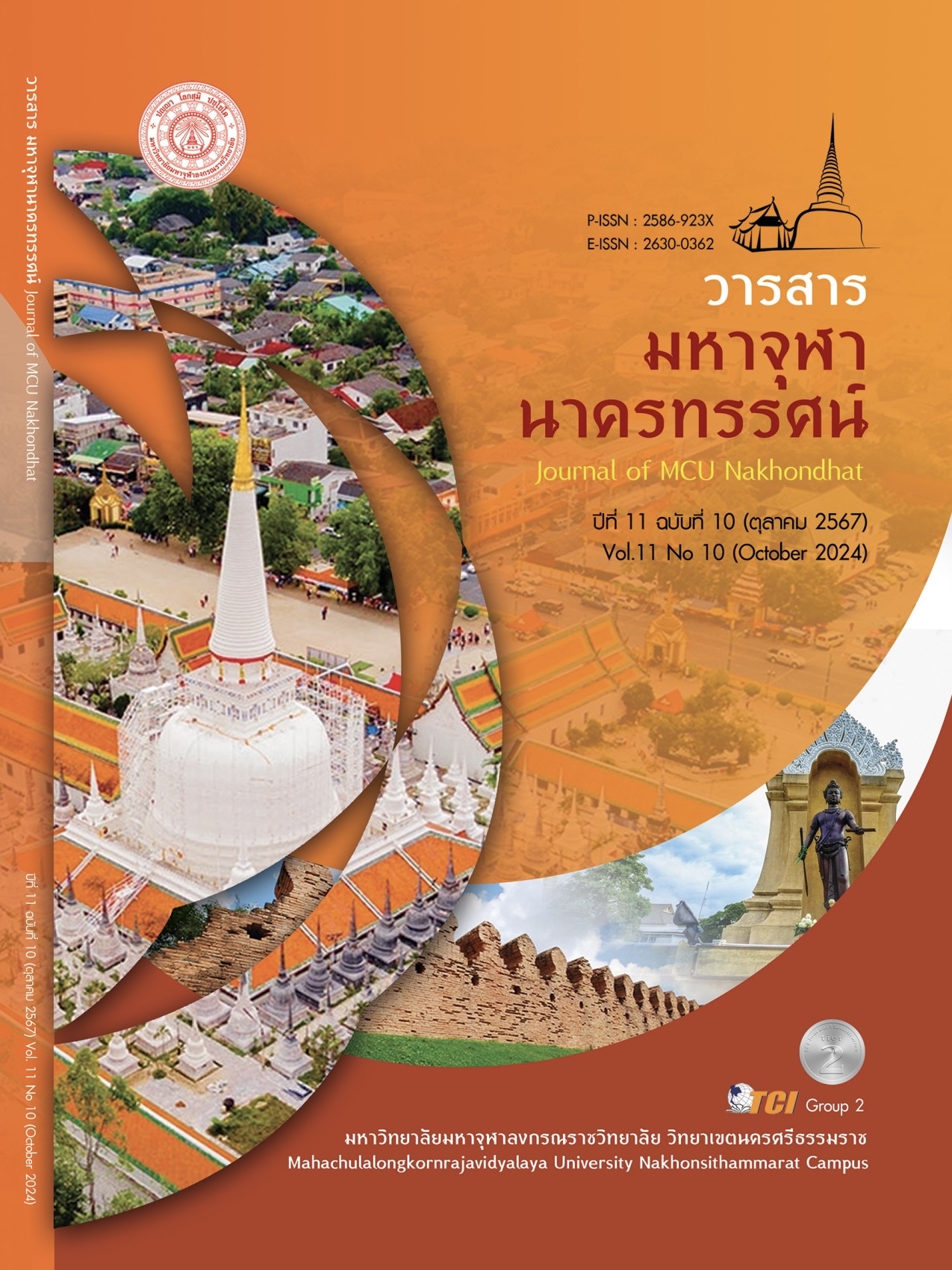DEVELOPMENT OF HUMAN RESOURCE MANAGEMENT SYSTEM TO BECOME A HIGH-PERFORMANCE ORGANIZATION IN ACCORDANCE WITH GOOD GOVERNANCE PRINCIPLES
Main Article Content
Abstract
A study of the This research on the Development of Human Resource Management System towards a High Performance Organization Based on Good Governance has the following objectives: 1) The study the human resource management system towards a high performance organization based on good governance; 2) The compare the human resource management systems towards a high performance organization based on good governance; and 3) To study the approach to developing the human resource management system towards a high performance organization based on good governance. This research is a quantitative research. The sample used in the research is the people in Phra Nakhon Si Ayutthaya Municipality by purposive selection, totaling 100 people. The research instrument is a questionnaire. The statistical analysis is done by finding the mean, frequency, percentage, standard deviation, and testing the hypothesis with t-value and F-value. The research results found that 1) The overall human resource management system for high-performance organizations based on good governance was at a high level in each aspect; 2) The results of the comparison of human resource management systems for high-performance organizations based on good governance classified by gender and age were different in all aspects; and 3) The results of the research on the development of human resource management systems for high-performance organizations based on good governance found that 1) In terms of manpower management, the government sector should prepare a workforce plan by analyzing, planning policies, and preparing manpower data; 2) In terms of system and innovation development, the government sector should develop systems and innovations, based on local wisdom; and 3) In terms of digital technology development, the government sector should develop a digital technology infrastructure system that is modern and widely distributed.
Article Details

This work is licensed under a Creative Commons Attribution-NonCommercial-NoDerivatives 4.0 International License.
References
กรรณิการ์ สุวรรณศรี. (2559). การบริหารทรัพยากรมนุษย์. นครปฐม: มหาวิทยาลัยราชภัฏนครปฐม.
ชัยวิชญ์ เข็มปัญญา. (2563). สภาพและแนวทางการพัฒนาการใช้เทคโนโลยีดิจิทัลเพื่อการศึกษาของโรงเรียนในสังกัดสำนักงานเขตพื้นที่การศึกษามัธยมศึกษา เขต 22. วารสารวิชาการมหาวิทยาลัยราชภัฏศรีสะเกษ, 14(3), 35-42.
ดุสิต ขาวเหลือง. (2554). การฝึกอบรมที่มีประสิทธิภาพและสมรรถนะ. ชลบุรี: มหาวิทยาลัยบูรพา.
ธนัชพร โมราวงษ์. (2555). ปัจจัยทางจิตวิทยาองค์การที่มีอิทธิพลต่อการนำไปสู่องค์การแห่งความเป็นเลิศ: กรณีศึกษาโรงงานในเขตนิคมอุตสาหกรรมบางปู จังหวัดสมุทรปราการ. วารสารวิชาการมหาวิทยาลัยอีสเทิร์นเอเชีย, 2(2), 253-267.
ปธาน สุวรรณมงคล. (2558). การบริหารงานภาครัฐกับการสร้างธรรมาภิบาล. กรุงเทพมหานคร: สถาบันพระปกเกล้า.
ปวลิน โปษยานนท์. (2557). การพัฒนารูปแบบโครงสร้างองค์กรที่มีสมรรถนะสูงของบริษัทปูนซีเมนต์ไทย. วารสารการเมืองการบริหารและกฎหมาย, 6(3), 303-314.
มหาวิทยาลัยศรีนครินทรวิโรฒ. (2566). การเป็นองค์กรที่มีสมรรถนะสูงและมีธรรมาภิบาล. กรุงเทพมหานคร: มหาวิทยาลัยศรีนครินทรวิโรฒ.
วลัยพร สุขปลั่ง และคณะ. (2563). การพัฒนาบุคลากรมุ่งสู่องค์การที่มีสมรรถนะสูง. อุบลราชธานี: มหาวิทยาลัยราชภัฏอุบลราชธานี.
ศรีสมบัติ นวนพรัตน์สกุล และคณะ. (2554). การศึกษาศักยภาพในการพัฒนาคณะเภสัชศาสตร์ มหาวิทยาลัยศิลปากรไปเป็นองค์กรที่มีขีดสมรรถนะสูง. วารสารมหาวิทยาลัยอุบลราชธานี, 2(2), 189-203.
ศศิรัศมิ์ ประสาทแก้ว. (2556). ปัจจัยเชิงสาเหตุพหุระดับในการพัฒนามหาวิทยาลัยสู่องค์กรสมรรถนะสูงแบบบูรณาการพหุมิติศึกษากรณีมหาวิทยาลัยวลัยลักษณ์ มหาวิทยาลัยทักษิณและหาวิทยาลัยสงขลานครินทร์. ใน ดุษฎีนิพนธ์การศึกษาดุษฎีบัณฑิต สาขาวิชาภาวะผู้นำทางการบริหารการศึกษา. มหาวิทยาลัยทักษิณ.
สมนึก ภัทธิยธานี. (2544). การวัดผลการศึกษา. กาฬสินธุ์: ประสานการพิมพ์.
สหธร เพชรวิโรจน์ชัย. (2566). การเข้าใจคนอื่นด้วยความเข้าอกเข้าใจ. เรียกใช้เมื่อ 26 มีนาคม 2566 จาก https://positioningmag.com/1309169
สำนักงานคณะกรรมการพัฒนาระบบราชการ. (2566). การพัฒนาบุคลากรมุ่งสู่องค์การที่มีสมรรถนะสูงตามหลักธรรมาภิบาล. กรุงเทพมหานคร: สำนักงานคณะกรรมการพัฒนาระบบราชการ.
สุพรรษา เศษแสงศร และสุรศักดิ์ ชะมารัมย์. (2559). การพัฒนาองค์การสู่การเป็นองค์การที่มีขีดสมรรถนะสูงของสำนักงานจัดหางานจังหวัดในภาคตะวันออกเฉียงเหนือ. วารสารบัณฑิตศึกษา, 13(61), 197-210.
Cronbach, L. J. (1990). Essentials of psychological testing. New York: Harper & Row.
Delahaye, B. L. (2000). Human Resource Development: Principles and Practice. Milton: John Wiley & Sona Australia Ltd.
Gilley, J. W. et al. (2002). Principles of Human ResourceDevelopment. Cambridge, Morocco: Perseus Publihing.
Grieves, M. (2003). Digital Twin. New York: McGraw-Hill.
Harrison, R. & Kessels, J. (2004). Human resource development in a knowledge economy. An organizational view. New York: Hampshire.
Shafritz, E. D. S. (2001). Ethics: Facing Up To The Issues. London: The Economist BooKS.
Swanson, E. et al. (2009). Foundations of Human-resource Development. Retrieved March 10, 2023, from https://lsms.ac/wp-content/uploads/2023/02/18.pdf
Yorks, L. (2005). Strategic human resource development. Mason, Ohio: South Western Thomson.


